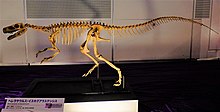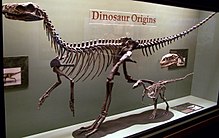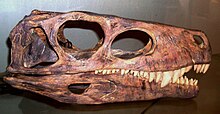Herrerasaurus
| Herrerasaurus | |
|---|---|

| |
| Skeleton replica | |
| Scientific classification | |
| Domain: | Eukaryota |
| Kingdom: | Animalia |
| Phylum: | Chordata |
| Clade: | Dinosauria (?) |
| Clade: | Saurischia (?) |
| Family: | †Herrerasauridae |
| Genus: | †Herrerasaurus Reig, 1963 |
| Species: | †H. ischigualastensis
|
| Binomial name | |
| †Herrerasaurus ischigualastensis Reig, 1963
| |
| Synonyms | |
| |
Herrerasaurus is likely a genus of saurischian dinosaur from the Late Triassic period. This genus was one of the earliest dinosaurs from the fossil record. Its name means "Herrera's lizard", after the rancher who discovered the first specimen in 1958 in South America. All known fossils of this carnivore have been discovered in the Ischigualasto Formation of Carnian age (late Triassic according to the ICS, dated to 231.4 million years ago) in northwestern Argentina.[1] The type species, Herrerasaurus ischigualastensis, was described by Osvaldo Reig in 1963[2] and is the only species assigned to the genus. Ischisaurus and Frenguellisaurus are synonyms.
For many years, the classification of Herrerasaurus was unclear because it was known from very fragmentary remains. It was
It is a member of the
Discovery
Herrerasaurus was named by
Reig believed Herrerasaurus was an early example of a
Two other partial skeletons, with skull material, were named Frenguellisaurus ischigualastensis by

A complete Herrerasaurus skull was found in 1988, by a team of paleontologists led by
The study of early dinosaurs such as Herrerasaurus and Eoraptor therefore has important implications for the concept of dinosaurs as a
Description

Herrerasaurus was a lightly built bipedal carnivore with a long tail and a relatively small head. Adults had skulls up to 56 cm (22 in) long and were up to 6 m (20 ft) in total length[4] and 350 kg (770 lb) in weight.[38] Smaller specimens were about 4.5 m (15 ft) long and weighed about 200 kg (440 lb).[39]
Herrerasaurus was fully bipedal. It had strong hind limbs with short
Herrerasaurus displays traits that are found in different groups of dinosaurs, and several traits found in non-dinosaurian archosaurs. Although it shares most of the characteristics of dinosaurs, there are a few differences, particularly in the shape of its hip and leg bones. Its pelvis is like that of saurischian dinosaurs, but it has a bony
Herrerasaurus had a long, narrow skull that lacked nearly all the specializations that characterized later dinosaurs,[41] and more closely resembled those of more primitive archosaurs such as Euparkeria. It had five pairs of fenestrae (skull openings) in its skull, two pairs of which were for the eyes and nostrils. Between the eyes and the nostrils were two antorbital fenestrae and a pair of tiny, 1-centimeter-long (0.39 in) slit-like holes called promaxillary fenestrae.[42]
Herrerasaurus had a flexible joint in the lower jaw that could slide back and forth to deliver a grasping bite.[41] This cranial specialization is unusual among dinosaurs but has evolved independently in some lizards.[43] The rear of the lower jaw also had fenestrae. The jaws were equipped with large serrated teeth for biting and eating flesh, and the neck was slender and flexible.[17][41]
According to Novas (1993), Herrerasaurus can be distinguished based on the following features:
According to Sereno (1993), Herrerasaurus can be distinguished based on the following features, all of which are unknown in other herrerasaurids:
Classification

Herrerasaurus was originally considered to be a genus within
Proposed in 1987 by Brinkman and Sues, Herrerasaurus has at times been considered basal to

In a revision of basal Dinosauria, Padian and May (1993) discussed the definition of the clade, and redefined it as the latest common ancestor of Triceratops and birds. They also discussed what this definition would do to the most basal taxa, such as Herrerasauridae, and Eoraptor. Padian and May considered that since both Herrerasauridae and Eoraptor lack many diagnostic features of Saurischia or Ornithischia, that they could not be considered inside Dinosauria.[54]
A later 1994 study by Novas instead classified Herrerasaurus within Dinosauria, and strongly supported its position within Saurischia, as well as provided synapomorphies that it shared with Theropoda. Novas found that the primitive features of lacking a brevis fossa and having only two sacral vertebrae were simply reversals found in the genus.
In 2010, Alcocer and Martinez described a new taxon of herrerasaurid, Sanjuansaurus. It could be distinguished from Herrerasaurus based on multiple features. In the phylogenetic analysis, Herrerasaurus, Sanjuansaurus and Staurikosaurus all were in a polytomy, and Herrerasauridae was the most primitive group of saurischian, outside Eusaurischia, Eoraptor and Guaibasaurus.[1] In 2011, Martinez et al. described Eodromaeus, a basal theropod from the same formation as Herrerasaurus. In a phylogenetic analysis, Eoraptor was placed within Sauropodomorpha, Herrerasauridae was placed as the most basal theropods, and Eodromaeus was placed as the next most basal.[60] A more recent analysis, by Bittencourt et al. (2014), placed Herrerasauridae in a polytomy with Theropoda and Sauropodomorpha, with Eoraptor also being in an unresolved position. This cladogram is shown below.[61]

Dinosauria
|
|
Other members of the
Paleobiology

The teeth of Herrerasaurus indicate that it was a
Coprolites (fossilized dung) containing small bones but no trace of plant fragments, discovered in the Ischigualasto Formation, have been assigned to Herrerasaurus based on fossil abundance. Mineralogical and chemical analysis of these coprolites indicates that if the referral to Herrerasaurus was correct, this carnivore could digest bone.[67]
Comparisons between the
In a 2001 study conducted by Bruce Rothschild and other paleontologists, 12 hand bones and 20 foot bones referred to Herrerasaurus were examined for signs of stress fracture, but none were found.[69]
PVSJ 407, a Herrerasaurus ischigualastensis, had a pit in a skull bone attributed by Paul Sereno and Novas to a bite. Two additional pits occurred on the splenial. The areas around these pits are swollen and porous, suggesting the wounds were afflicted by a short-lived non-lethal infection. Because of the size and angles of the wound, it is likely that they were obtained in a fight with another Herrerasaurus.[70]
Paleoecology

The holotype of Herrerasaurus (PVL 2566) was discovered in the Cancha de Bochas Member of the Ischigualasto Formation in San Juan, Argentina. It was collected in 1961 by Victorino Herrera, in sediments that were deposited in the Carnian stage of the Triassic period, approximately 231 to 229 million years ago.[71] Over the years, the Ischigualasto Formation produced other fossils ultimately referred to Herrerasaurus. In 1958, A.S. Romer discovered specimen MCZ 7063, originally referred to Staurikosaurus in Carnian sediments. Herrerasaurus specimens PVL 2045 and MLP(4)61, were collected in 1959 and 1960, respectively, in sediments that were deposited in the Norian stage of the Triassic period, approximately 228 to 208 million years ago. However, these specimens are no longer regarded as pertaining to Herrerasaurus.[5][72][73] In 1960, Scaglia collected specimen MACN 18.060, originally the holotype of Ischisaurus cattoi, in sediments deposited in the Carnian stage. In 1961, Scaglia collected Herrerasaurus specimen PVL 2558, in the Carnian beds of this formation. In 1990, the Cancha de Bochas Member produced more Herrerasaurus specimens, also from its Carnian beds.[74] Specimen PVSJ 53, originally the holotype of Frenguellisaurus ischigualastensis, was collected by Gargiulo & Oñate in 1975 in sediments that were deposited in the Carnian stage.[10]
Although Herrerasaurus shared the body shape of the large carnivorous dinosaurs, it lived during a time when dinosaurs were small and few. It was the time of non-dinosaurian reptiles, not dinosaurs, and a major turning point in the Earth's ecology. The vertebrate fauna of the Ischigualasto Formation and the slightly later
Studies suggest that the
References
- ^ PMID 21594020.
- ^ a b c d Reig, O.A. (1963). "La presencia de dinosaurios saurisquios en los "Estratos de Ischigualasto" (Mesotriásico Superior) de las provincias de San Juan y La Rioja (República Argentina)". Ameghiniana (in Spanish). 3 (1): 3–20.
- .
- ^ S2CID 1640394.
- ^ ISSN 0895-9811.
- PMID 27839975.
- ISSN 0024-4082.
- PMID 32842895.
- S2CID 232313141.
- ^ ISBN 978-0-520-24209-8.
- PMID 30785940.
- S2CID 182843217.
- S2CID 8349110..
- ^ Airhart, Marc (December 10, 2009). "New Meat-Eating Dinosaur Alters Evolutionary Tree". Jackson School of Geosciences. Archived from the original on March 10, 2010.
- S2CID 4270484.
- ^ S2CID 35644127.
- ^ .
- ^ Steel, R. (1970). "Part 14. Saurischia. Handbuch der Paläoherpetologie/Encyclopedia of Paleoherpetology". Gustav Fischer Verlag, Stuttgart: 1–87.
- S2CID 84931897.
- ^ a b c Brinkman, D.B.; Sues, H.D. (1987). "A staurikosaurid dinosaur from the Upper Triassic Ischigualasto Formation of Argentina and the relationships of the Staurikosauridae" (PDF). Palaeontology. 30 (3): 493–503. Archived from the original (PDF) on December 8, 2015. Retrieved October 20, 2015.
- ^ a b c Novas, F.E. (1992). "Phylogenetic relationships of the basal dinosaurs, the Herrerasauridae" (PDF). Palaeontology. 35 (1): 51–62. Archived from the original (PDF) on December 8, 2015. Retrieved October 20, 2015.
- .
- S2CID 132827962.
- ^ Gauthier, J.A.; Cannatella, D.; Queiroz, K.; Kluge, A.G. & Rowe, T. (1989). "Tetrapod phylogeny". In B. Fernholm; K. Bremer & Jörnvall, H. (eds.). The Hierarchy of Life. Amsterdam: Elsevier Science Publishers B. V. pp. 337–353.
- ^ Novas, F. E. (1986). "Un probable terópodo (Saurischia) de la Formación Ischigualasto (Triásico superior), San Juan, Argentina". IV Congreso Argentino de Paleontología y Bioestratigrafía, Mendoza, November 23–27 (in Spanish). 2: 1–6.
- ^ S2CID 1640394.
- ^ Holtz, T.R. Jr.; Padian, K. (1995). "Definition and diagnosis of Theropoda and related taxa". Journal of Vertebrate Paleontology. 15 (3, supplement): 35A.
- ^ Bonaparte, J.F.; Pumares, J.A. (1995). "Notas sobre el primer cráneo de Riojasaurus incertus (Dinosauria, Prosauropoda, Melanorosauridae) del Triásico superior de La Rioja, Argentina". Ameghiniana (in Spanish). 32: 341–349.
- ^ Rauhut, O.W.M. (2003). "The interrelationships and evolution of basal theropod dinosaurs". Special Papers in Palaeontology. 69: 1–213.
- S2CID 220415208.
- S2CID 55723635.
- S2CID 6050601.
- S2CID 8349110. Archived from the originalon July 11, 2007. Retrieved July 20, 2007.
- .
- ^ Arcucci, A. C.; Forster, C.; May, C.; Abdala, F.; Marsicano, C. (1998). "Una nueva icnofauna de la Formación Los Rastros, Triásico Medio, en la Quebrada de Ischichuca Chica (Provincia de La Rioja, Argentina)". Acta Geológica Lilloana (in Spanish). 18: 152.
- S2CID 4220935.
- ^ Bonaparte, J. F. (1976). "Pisanosaurus mertii Casimiquela and the origin of the Ornithischia". Journal of Paleontology. 50: 808–820.
- ^ ISBN 978-0-671-68733-5.
- OCLC 985402380.
- .
- ^ .
- S2CID 84270944.
- ^ McDowell, S.B. Jr.; Bogert, C.M. (1954). "The systematic position of Lanthanotus and the affinities of the anguinomorphan lizards". Bulletin of the American Museum of Natural History. 105: 1–142.
- .
- .
- ^ .
- .
- S2CID 86687464. Archived from the original(PDF) on September 24, 2015.
- .
- ^ Benedetto, J.L. (1973). "Herrerasauridae, nueva familia de saurisquios triasicos" (PDF). Ameghiniana. 10 (1): 89–102.
- S2CID 129438498.
- .
- ^ ISBN 978-0-520-25408-4.
- ^ Padian, K.; May, C.L. (1993). "The Earliest Dinosaurs". In Lucas, Spencer G.; Morales, M. (eds.). The Nonmarine Triassic. New Mexico Museum of Natural History & Science Bulletin 3. pp. 379–381. Retrieved February 21, 2024 – via Google Books.
- .
- JSTOR 4523770.
- S2CID 34530296.
- S2CID 8349110.
- S2CID 129244872.
- ^ S2CID 33506648.
- S2CID 56155733.
- ^ Long, R.A.; Murry, P.A. (1995). "Late Triassic (Carnian and Norian) Tetrapods from the Southwestern United States". New Mexico Museum of Natural History and Science, Bulletin. 4: 1–254.
- .
- .
- ^ Kischlat, E.-E. (1999). "A new dinosaurian "rescued" from the Brazilian Triassic: Teyuwasu barberenai, new taxon". Paleontologia Em Destaque, Boletim Informativo da Sociedade Brasileira de Paleontologia. 14 (26): 58.
- ISBN 978-0-520-06726-4.
- S2CID 131242248.
- S2CID 33253407.
- ^ Rothschild, B., Tanke, D. H., and Ford, T. L., 2001, Theropod stress fractures and tendon avulsions as a clue to activity: In: Mesozoic Vertebrate Life, edited by Tanke, D. H., and Carpenter, K., Indiana University Press, pp. 331–336.
- ^ Molnar, R. E., 2001, Theropod paleopathology: a literature survey: In: Mesozoic Vertebrate Life, edited by Tanke, D. H., and Carpenter, K., Indiana University Press, pp. 337–363.
- ISSN 0895-9811.
- ^ S2CID 37918101.
- S2CID 135096489.
- S2CID 4270484.
- ISBN 978-0-253-21313-6.
- doi:10.1016/0031-0182(82)90034-7. Archived from the original(PDF) on January 26, 2009. Retrieved July 23, 2009.
- ^ Columbi, Carina E. (October 5, 2008). Stable isotope analysis of fossil plants from the Upper Triassic Ischigualasto Formation in the northwest of Argentina. Houston, Texas: The Geological Society of America. Archived from the original on January 11, 2012. Retrieved July 23, 2009.
- ^ Bonaparte, J.F. (1979). "Faunas y paleobiogeografía de los tetrápodos mesozoicos de América del Sur". Ameghiniana, Revista de la Asociación Paleontológica Argentina (in Spanish). 16 (3–4): 217–238.
External links
 Wikijunior Dinosaurs/Herrerasaurus at Wikibooks
Wikijunior Dinosaurs/Herrerasaurus at Wikibooks Media related to Herrerasaurus at Wikimedia Commons
Media related to Herrerasaurus at Wikimedia Commons Data related to Herrerasaurus at Wikispecies
Data related to Herrerasaurus at Wikispecies- Introduction to Herrerasaurus, from the University of California Museum of Paleontology


